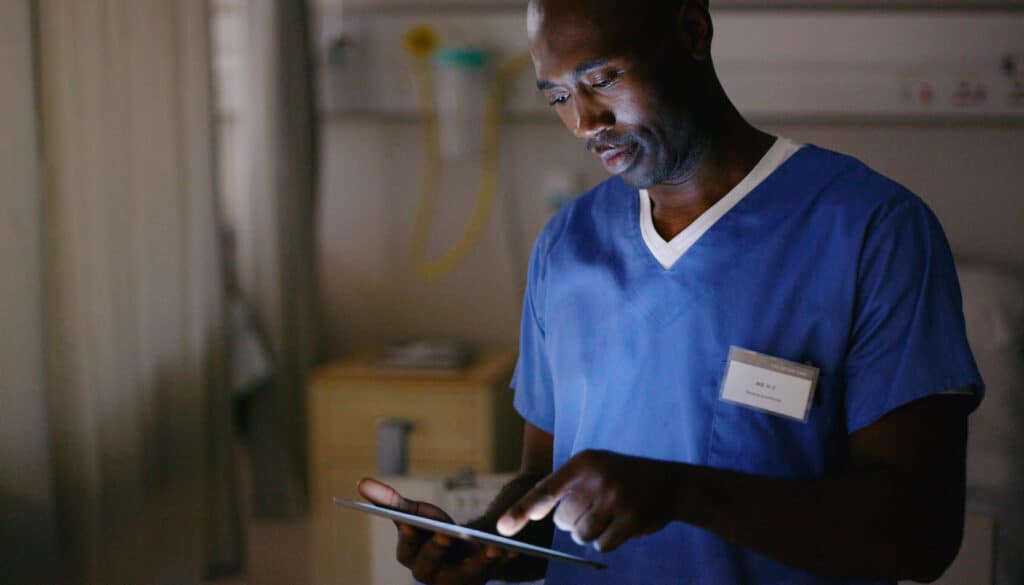Patient monitoring is a critical aspect of healthcare, especially for those patients who require constant monitoring of their health conditions. However, it can be very complicated and costly to maintain constant monitoring, in some cases even requiring more inpatient care. Advancements in technology within the healthcare industry have made way for tremendous improvements in remote patient monitoring.
What is Remote Patient Monitoring (RPM)
Remote patient monitoring (RPM) is a specific form of telehealth. RPM is a form of healthcare delivery using technology to monitor a patient’s health in real time. This is done through a combination of devices and software that can track health information such as vital signs, medications, lifestyle habits, sleep activity, and more. The data collected from the devices is then transmitted to the healthcare provider for further analysis.
Remote patient monitoring allows healthcare professionals to monitor patients who are outside a healthcare facility via remote monitoring tools. This technology allows patient health data to be collected in real-time, transmitted securely, and analyzed effectively to make timely interventions when necessary. This makes it possible to monitor patients in real-time, thus improving healthcare outcomes.
Telehealth has its advantages and disadvantages, but there are a lot of positives. RPM can increase patient engagement in their own care and reduce hospital admissions while making it possible to get accurate data on a patient’s condition outside of an acute or long-term care environment. Remote monitoring is leading to more preventive and personalized care for patients and can improve patient outcomes and increase efficiency in healthcare delivery.
Remote patient monitoring provides healthcare professionals with improved visibility into a patient’s health and is being used to monitor chronic conditions such as heart failure, diabetes, COPD, obesity, hypertension, and more. The technology also has great potential for preventive care, such as tracking activity levels to assess for risk of falls or detecting early signs of infection.
4 Types of Remote Patient Monitoring Systems
When it comes to remote patient monitoring, there are four main types of systems. These RPM systems can be used by healthcare providers to allow for remote monitoring and better patient care.
- Wearable Medical Devices: These are small electronic devices that are worn by patients and can be used to track vital signs such as heart rate, blood pressure, and pulse oximetry.
- Mobile Health Applications: Mobile health apps can be used to collect data from wearable devices and other biosensors. They can also be used to collect lifestyle data such as diet and exercise.
- Cloud-Based Systems: These are systems that are hosted on the cloud and used to collect and store patient data.
- Telemedicine Platforms: Telemedicine platforms can be used to link healthcare providers with patients through video conferencing or other forms of remote communication.
Patient data collected through remote patient monitoring systems is kept secure, utilizing the latest encryption and security protocols to ensure patient privacy and HIPAA compliance.
What Do Healthcare Professionals Need to Know
As healthcare technology advances, RPM is becoming more prevalent. Healthcare professionals should be aware of how it works and how it can benefit their patients.
First, RPM empowers healthcare providers to collect vital health data from patients’ homes, enabling continuous tracking of symptoms and changes in vital signs, which can reveal emerging health problems or issues. Healthcare providers can take immediate action to prevent them from becoming severe and costly.
Secondly, home health care is an excellent candidate for RPM. Long-term or chronic patients can benefit significantly from RPM technology, which allows for continuous monitoring from the comfort of their own homes. RPM also eliminates the need for frequent and only short visits to the clinic, freeing up healthcare staff to focus on more complicated cases.
Often times healthcare technology companies offer turnkey solutions that can integrate seamlessly into existing EHR systems. These solutions are built to be user-friendly for both healthcare providers and patients. Clear and straightforward technology increases the likelihood of program adoption and patient engagement.
What are the Benefits of Remote Patient Monitoring
RPM offers a monumental opportunity to deliver high-quality, patient-centered care. While there are potential drawbacks, the growing interest in RPM suggests its potential outweighs its cons. RPM can provide greater accessibility to patients with convenient and home-based care in remote and rural areas as well as for elderly patients and those with physical disabilities.
By leveraging technology, patients are more involved in their healthcare, leading to better outcomes. Real-time monitoring allows healthcare providers to identify potential issues early, take quick action, and provide tailored solutions to their patients. This, in turn, has created more significant opportunities for healthcare providers and has led to a reduction in healthcare costs.
All of these benefits are why RPM is quickly becoming an essential part of healthcare delivery today. Technological advancements have revolutionized patient monitoring and as technology continues to evolve, so will its application and benefits to the healthcare industry and its providers.
search content
subscribe to
the shc blog


